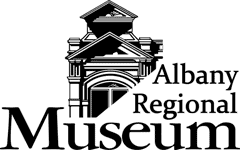By Cathy Ingalls, Albany Regional Museum board member
Museum Director, Keith Lohse, showing off a Timber Carnival hat to visiting children. Photo courtesy Leila Hallan
So who wants to go to work every day in a tall building, where there are stairs to climb, the temperature can be as low as 60 degrees, the humidity is about 35 percent, and the lights on one floor are mostly off.
Well if you are the executive director or the collections and exhibits manager at the Albany Regional Museum you do. Keith Lohse and Amy Bozorth both love history, and they believe it is important to preserve historical objects.
The working conditions are necessary to protect the museum’s thousands of artifacts housed mostly on the building’s second floor.
The job of preserving and cataloguing antiques be they books, papers, textiles, wood objects, military uniforms, paintings, furniture and even a full-sized horse-drawn buggy is a complicated one that is time consuming.
There’s paperwork to do plus entering information and photographs into the museum’s computers, giving the items tracking numbers and figuring out the best way to store them.
American Legion Medal placed in an acid free box purchased through the new sponsor an object program. Photo courtesy Amy Bozorth
Some artifacts require being kept in acid-free boxes that can cost $100 each.
Since Bozorth was hired in February 2018, she and her team of volunteers have catalogued more than 31,000 objects; 11,000 photos, 9,000 paper archives and 8,000 textiles and other items.
These objects go back to books from the early 1800s while other items date from the late 1800s to the early 1900s.
In his bits of down time, Lohse likes to take a few minutes to take strolls around what all is in the museum’s collection.
He said he’s partial to the World War II bomber outfit worn by Charles Langmack of Lebanon, the man who gave the Albany airport its start.
Expensive, special-sized boxes were purchased to store the clothing flat to prevent the leather from cracking.
The bomber jacket worn by Charles Langmack. Photo courtesy Kay Burt
Because the museum is on a limited budget, a sponsorship program was developed to help cover costs associated with the preservation of the museum’s collection.
To view those items in need of special protection visit the museum’s website: armuseum.com and click on Support and then scroll down to Sponsor an Object.
Museum work is a calling, Lohse said. He got his call while studying at Butler University in Indiana to become a pharmacist.
Lohse realized that he was not prepared for a job in pharmacy as there was too much science, mostly chemistry involved, so then he considered religious studies but couldn’t figure out what jobs might be available after graduation.
During this time, he visited the art museum in Indianapolis and the trajectory of his career was decided, except for a brief time spent in the trucking industry.
Lohse enjoys running a small museum because, “I get to oversee everything.” His management style is to let employees do their job with little interference from him.
Currently, Lohse and Bozorth are determining what objects in the collection can be used in upcoming exhibits.
“We have a five-year plan for the exhibits, which will require funding and volunteer time,” Lohse said. “Meanwhile, we are working to grow membership, recruit volunteers to help with the collection, find speakers for the monthly History Bites programs, lead school tours, consolidate objects on the second floor on new shelving racks, and help with the annual parlour tour.”
His job also involves efforts to build financial support and to obtain grants.
To learn more about the museum, hear a number of ways to volunteer and to find out about donating an object to the collection call 541-967-7122.
The museum at 136 Lyon St. S is open between 11 a.m. and 4 p.m. Tuesday through Friday and 10 a.m. to 2 p.m. Saturday.



